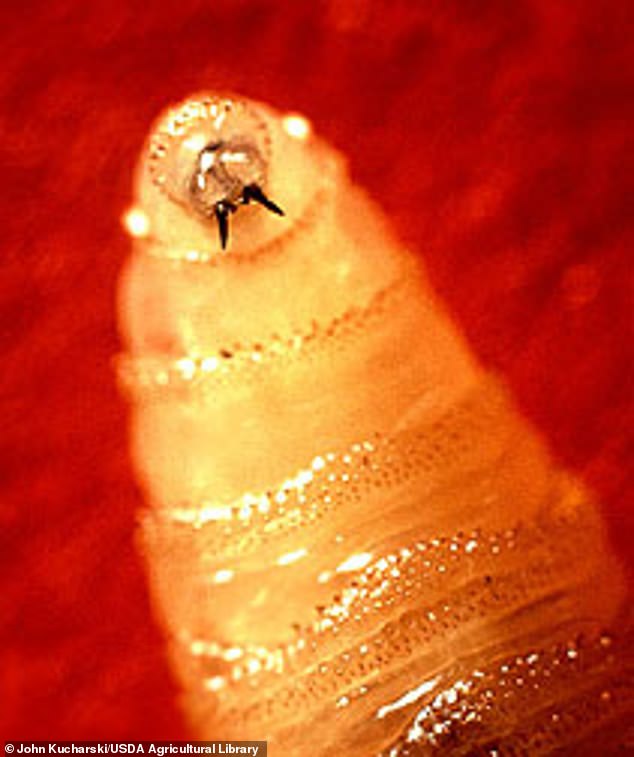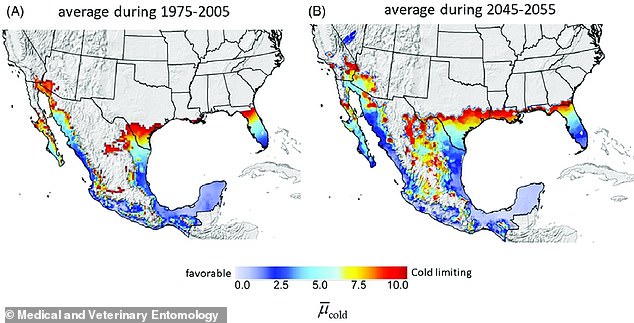By LUKE ANDREWS U.S. SENIOR HEALTH REPORTER
An American has been infested with a flesh-eating parasite in what officials believe is the first documented case-of-its-kind in the US.
The parasite, the New World screwworm, eats living flesh and typically causes death within two weeks from tissue damage and bacterial infections.
The patient, who was not named, was in Maryland and had recently returned to the US from El Salvador, where there is an outbreak of the worm.
Department of Health and Human Services officials revealed the case but stressed that the risk to the public was ‘very low’.
Screwworms are parasitic flies that lay eggs in the open wounds of any warm-blooded animals, including humans.
These hatch in seven days, and release hundreds of larvae with razor-sharp teeth that burrow into living flesh, much like maggots eat through wood.
The worms were eliminated in the US in 1966, but sporadic cases have been detected since amid outbreaks in Central America. The latest case is not the first case ever in the US, but the first case in an individual who had traveled to the US from a country battling an outbreak.
The infection was first reported by officials in Maryland and at the CDC on August 4 but was confirmed by HHS on Sunday.

A patient was found to be infested with the New World screwworm after returning to the US from El Salvador (stock image)
No further details on the case were revealed, which officials said was due to patient privacy laws.
DailyMail.com contacted the CDC, which reiterated that the risk to the public was ‘very low’ but did not say whether the patient was hospitalized or whether they had now been discharged.
An HHS spokesman said: ‘This is the first human case of travel-associated New World screwworm myiasis (parasitic infestation of fly larvae) from an outbreak-affected country identified in the United States.
‘The risk to public health in the United States from this introduction is very low.’
Previous reports had suggested the individual returned to the US from Guatemala, although in its release Sunday officials said the patient had traveled from El Salvador.
Screwworms rarely infest humans, instead tending to target cattle and wildlife, in which they can be devastating.
Treatment involves removing hundreds of larvae and thoroughly disinfecting wounds.
It is possible to survive an infection if patients are treated early and the screwworms are removed, but it can be fatal within two weeks.

Screwworms have been causing sporadic cases in the US amid outbreaks in Central America that began in 2023. Shown above is a migrant caravan heading to the US in November 2024

The above map shows areas that the screwworm could inhabit in blue. These include parts of Florida and Texas
In a similar case from last year, a patient in Florida was confirmed to be infested after returning from a vacation in the Dominican Republic.
In 2023, an individual who returned to Arkansas after visiting Brazil and Argentina was found to have an infestation of screwworms in a surgical wound.
And in 2014, a traveler returned to Washington state infested with the parasite also after visiting the Dominican Republic.
None of the patients were reported to have died from the infestations.
An outbreak was also recorded in deer in the Florida Keys in 2016, which led to the deployment of hundreds of officials to contain the parasite.
Screwworms are found in Central and South America and the Caribbean but have been traveling north since 2023.
Last year, they were detected in southern Mexico for the first time, which led to restrictions on beef imports from Mexico into the US for fear of importing the parasite.
Screwworms spread when a female screwworm fly lays her eggs in the wound of a warm-blooded animal. It is rare for it to be passed on directly from person-to-person.
The case has been revealed a week after Agriculture Secretary Brooke Rollins visited Texas to reveal plans to build a new sterile fly facility in the state to control the pest.
The plant would release hundreds of millions of sterile screwworm flies, which would then mate with wild ones but lead their eggs not to hatch, halting an outbreak.
Traps have also been set along the US Mexico border, with the aim of revealing whether any of the insects have crossed into the US.
The USDA has estimated a screwworm outbreak could cost the economy in Texas, the biggest U.S. cattle-producing state, about $1.8 billion in livestock deaths, labor costs and medication expenses.












